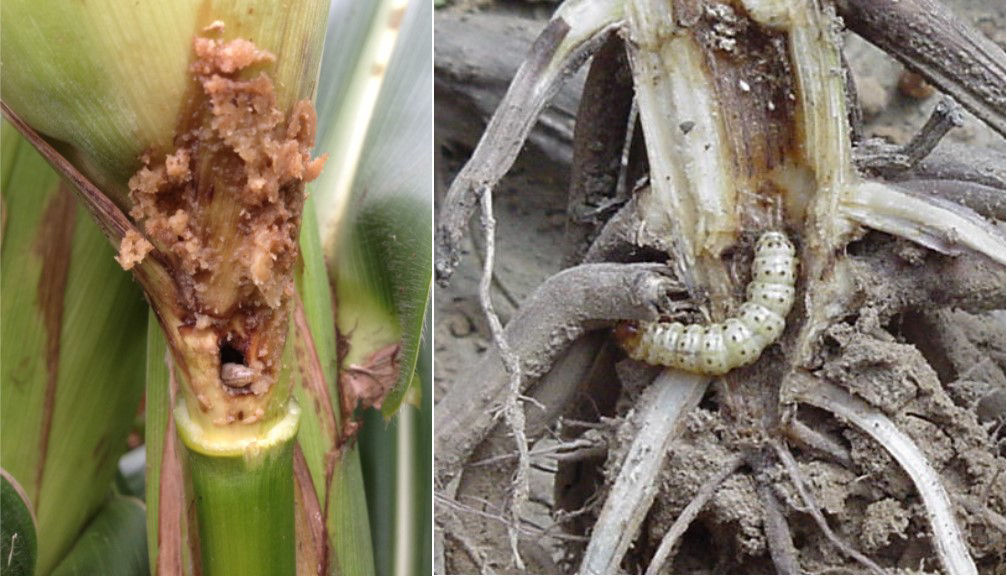Product Selection for Above Ground Insect Larvae
November 7, 2022
Insect larvae that feed on above ground corn tissue (stalks, leaves, ears) have the potential to decrease yield potential. Larvae that feed on stalks include European corn borer, southwestern corn borer, common stalk borer, and black cutworm (seedling plants). Foliage feeding larvae include European corn borer, fall armyworms, and black cutworm (seedlings). Ear feeding larvae include European corn borer, western bean cutworm, and corn earworm.
European corn borer has shown to reduce yield potential ranging from 6% loss/borer/plant in pre-tassel corn to 3% loss/borer/plant post pollination.1 Weakened stalks and ear shanks from European corn borer tunneling can cause lodging and ear drop (Figures 1 and 2). More common in southern states, southwestern corn borers tunnel into the stalk and girdle corn plants near the brace roots (Figure 2).


Corn earworm larvae feed on corn silks and developing kernels in the ear. Potential yield losses can be from a combination of direct kernel damage and reduced grain quality (Figure 3). Holes in husks resulting from earworm feeding can potentially be entry points for pathogens like Fusarium and Gibberella, which can produce mycotoxins.2

Insecticides are one way to help protect plants from insect feeding; however, application timing is critical to successful management. Corn products with Bacillus thuringiensis (B.t.) traits that control specific Lepidopteran pests offer long-lasting plant protection against crop injury. Several B.t. protection options are available including VT Double PRO® Technology which provides dual modes of action against specific above-ground larvae and Trecepta® Technology provides three modes of action to protect against key above-ground pests. (Table 1).
VT Double PRO® Technology provides protection against corn borers (European and southwestern), fall armyworm and corn earworm. Trecepta® Technology, which includes VT Double PRO® Technology and Vip3A, provides control for corn borers (European and southwestern), fall armyworm, corn earworm, western bean cutworm, and black cutworm.
Table 1. Modes of Action Against Specific Larvae for VT Double PRO® and Trecepta® Technologies.

Selecting Products
Corn products should be selected for a particular field based on a combination of agronomic characteristics that include disease tolerance, standability, adaptability to soil type, drought tolerance, yield potential, end use, and a trait package that helps protect yield potential. VT Double PRO® corn products and Trecepta® corn products are available to help protect corn plants from key above-ground pests; however, they do not have B.t. protection for corn rootworm (CRW). Therefore, these products should be used where CRW pressure is not a concern. In areas with CRW pressure, products with SmartStax® or SmartStax® PRO Technologies should be selected.
Sources:
1Potter, B. 2020. European corn borer in Minnesota field corn. University of Minnesota Extension. https://extension.umn.edu/corn-pest-management/european-corn-borer-minnesota-field-corn/.
2Tilmon, K., Paul, P., and Michel, A. 2018. Corn earworm making an unpleasant late-season appearance; watch for molds. C.O.R.N. Newsletter. 2018-32. Agronomic Crops Network. The Ohio State University Extension. https://agcrops.osu.edu/newsletter/corn-newsletter/2018-32/corn-earworm-making-unpleasant-late-season-appearance-watch-for-molds/.
Websites verified 9/9/22. 1219_51731